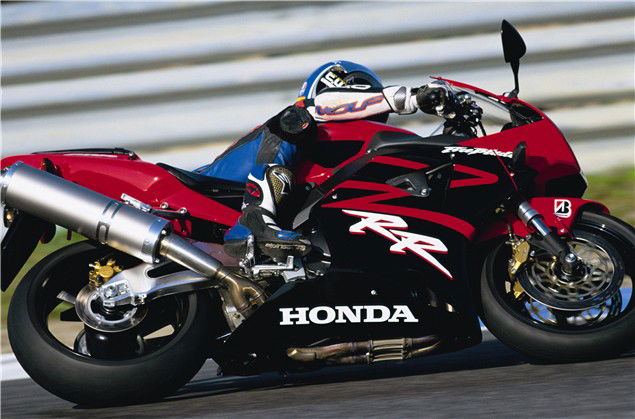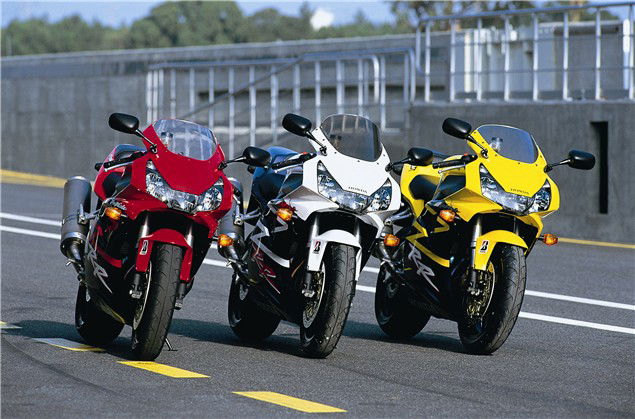2002 Honda CBR954RR Fireblade review
The 2002 Fireblade CBR954RR isn't just a face-lift. Beneath the fresh styling is a bigger, cleverer motor, updated suspension and brakes, new swingarm, a refined frame and lighter wheels and exhaust system.


When I took the 2002 Fireblade CBR954RR out for a spin I was impressed. Here was a machine with a fast, but torquey motor and with a really positive front end to it. My knowledge of road bikes of the time was that they were mostly all over the place and yet here was this bike, with a 16-inch front wheel, giving me the sort of feedback through the front end and excitement that was almost comparable to a race machine.
I still remember it now as one of the first times I'd ridden a road bike and got such a positive feeling from it. Since 1992 the FireBlade was the machine that others had to beat and nothing could come close to touching it until the Yamaha YZF-R1 came out in 1998.
Now, I know the FireBlade has gone through many changes over the intervening years, but personally, I don't really feel it's changed that much - until now.

The new for 2002 FireBlade isn't just a face-lift. Honda's R&D department and the man behind all the various incarnations of the Blade - Tadao Baba - have gone through the machine extremely thoroughly to give the bike a new feel. Underneath the fresh styling is a bigger, cleverer motor, updated suspension and brakes, new swingarm, a refined frame and lighter wheels and exhaust system.
On first appearances, this sixth-generation CBR900RR looks slimmer, sharper, smaller and more purposeful than any of the previous models. I've always felt that after the first couple of versions, the Blade has gone a little bit stale and frumpy. I mean, just compare the 2001 version to the GSX-R1000 or R1 and they don't come close. On the other hand the new model's subtle curves, more feline looking headlights, slimmed-down tail unit and colour schemes really knock the current model into a cocked hat. My favourite is the red and black, very much like a race bike. Second is the yellow model and personally I'd burn the white and blue machine - it's a bit too anaemic for me.

And all this is thanks to you, as Honda's brief for the new Blade was simple: listen to what the customer wants. This was why the Blade went all soft in the past, as customers wanted something which they could go two-up on, or something that was more comfortable to ride. Now owners want something different. They say they want the best performance, less weight, sharper looks and a slimmer machine.
If looking at the bike makes you realise it's smaller and more compact than before, then it was all confirmed when I finally got to throw a leg over the bike in the pitlane in Estoril. It both looks and feels a lot more compact and racey - just like the SP-2. The cockpit is classy too, if the norm for sports bikes these days - you've got the normal analogue tacho and a digital speedo. One addition for the Blade is the use of a rear wheel hugger. Apparently, Baba was dead against their use before, but after listening to what the customers wanted for the new Blade they all said they wanted an integral hugger, rather than having to go out and buy one. After all, if an R1 owner can have one free, why can't they?

The engine is in the150bhp claimed class, although Honda were stressing that this amount would be plus or minus 10bhp depending on what dyno you tested it on. Hmm... bit strange that. It almost seems as if they're getting their excuses in early, but the engineers really stressed this point, so we'll wait and see when we get one on test. Major changes internally include 42mm throttle bodies (up two mm from last year) and an updated PGM-FI ECU, which has a bigger memory and newly programmed control maps. This - along with a hike in capacity to 954cc - is the heart of the changes to the Blade.
Up in the dizzy heights of the rev range the bike peaks at a 11,500rpm redline, before hitting the limiter at 12,000rpm. To test the toughness of the motor Honda R&D boffins even kept the engine on the redline for 24 hours non-stop. It was still in one piece at the end, which is the kind of punishment even stupid journalists couldn't replicate. What's more impressive is the way the power comes in on the new Blade. On previous models - including Bertie's 2001 fuel-injected version - there's a hesitancy about the delivery, especially at low to medium revs. But on the new machine there's power a-plenty and that pregnant pause is replaced by tractable low to mid range pull, which tugs you up a completely linear slope towards a searing top end peak which is similar to the current model's. This big difference makes the new machine incredibly docile at low rpm, but also ensures that you get to max power quicker than a 13-year-old in a newsagents. It's handy to have these two modes of operation, softly-softly or balls out. Making this operation all the sweeter is the six speed gearbox, which warranted no extra words in my notes other than my future classic clichŽ, 'slicker than the Exxon Valdez.'

The brakes are also immediately astonishing. On the track they are nigh on perfect. Haul on the lever and you have massive power at your fingertips, they are simply fantastic. During each of the 30 minute sessions I was hammering the front end down into Estoril's Tarmac and still the front 330mm discs and four-pot brakes utterly refused to fade. What also helped for me was the new six-way adjustable lever. I like the lever set pretty close to the bar and with an extra two settings on the adjuster, you really can set it up to your liking. One thing I will say about the brakes is this. Where they are perfect on Estoril's curves with 16 or 17 degrees of ambient temperature, they may also be perhaps a little too sharp for muck encrusted roads that are all too common back home. The rear brake was fine. I use it quite a bit on the track, although obviously only on left handers, just to settle the bike down, or scrub off a little speed.
According to the engineers, the suspension was set up fairly stiff as standard for the track, but I still had to make changes to really get it set up to my liking. As I made changes during the day, I found the bike getting better and better as I made the settings stiffer and stiffer. Sometimes, when you go stiffer with the settings you end up dialling in some harshness, or even wheel spin, but that wasn't the case with the Blade, instead the changes simply made the tyres work that bit harder, more of which later.

As I said, the CBR was set up fairly stiff to begin with, but the changes I made were... On the front 43mm inverted forks, I started off with seven rings of preload showing and added one on that to make eight. Compression was originally at two from max, but I changed it to one from maximum. Rebound on the front started off at two from max and I kept this setting the same. At the rear I started off with plus four on the preload and added two clicks to that to make six. Compression started off at two from maximum and I went one click stiffer to make it one click off max. Rebound was originally set at two off maximum and I simply left it at that.
Honda reckoned they chose Estoril as it suited the bike perfectly. I would have preferred them to choose a circuit that didn't suit it at all - like Yamaha choosing the tight and twisty Cartagena for the R1 launch - a track so tight you wouldn't think a litre-sized bike could get around comfortably, let alone shine on. Still, perhaps Mallory in December isn't the best idea either! One thing Estoril did show up, was the the fact that you can really move around on the new Blade.

This model seems to have smaller dimensions, smaller tank and yet lower pegs than the Suzuki GSX-R1000. The fuel tank is 10mm shorter and 10mm lower than the previous one and these dimensions suited me and helped me to shift around the bike with ease. As the track went this way and that, I could move forward to get more weight and grip from the front in mid-corner, and then in an instant I could slide back again. It's a small thing, but on a race track it helps.
One thing that used to be a problem with the last generation of Blades was the generator cover touching down in left handers. This was a big headache for the superstock race boys early in 2000, but after trying my damnedest I couldn't get it down, so I reckon that problem is solved. Braking, turn-in, tracking... all of these things were no problem for the Blade. In fact, the only criticism I could find was that in medium to high speed corners the bike could get a little nervous.
It's nothing that a steering damper would not solve, but Honda are dead against fitting one as standard, saying that this would be like admitting they have a bad handling bike. Well, in 20 years of racing, I've had lots of brilliant handling bikes and they've all had steering dampers on. Anyway, lots of people fit them on the road just because they look so trick. If you want to spend a lot of time on a track and you're half decent, fit one. I reckon high speed stability could have been improved further with a bit of a fiddle with the ride height adjuster at the rear, but the Japanese technicians wouldn't let me.

Tyres are a new breed of Bridgestone, the BT012. Even with the front stiffened up for hard braking and better turn in and under hard acceleration, the tyres were as confidence inspiring as the suspension and brakes and the Bridgestone boys were saying that these were just standard compound rubber, not trick trackday tackle. The whole package was really starting to shine together as I got faster and faster around Estoril's curves.
So ultimately the question on everybody's lips is whether this could beat the Suzuki GSX-R1000 or Yamaha YZF-R1. Tough question without riding them all back to back, but I'll say this. With the FireBlade, I think less is most definitely more. Less cee cees than the GSX-R and R1, less weight than the GSX-R and R1 and yet more fun and more rideable. You can really thrash the Blade around, whereas with the GSX-R, you have to really give it some respect and it's hard to muscle it around. To all you fans out there, it's still a FireBlade at heart, but it's more like a new model than a development and it's a machine that I reckon is ultimately more satisfying to ride hard than a GSX-R1000.

Should you buy a 2002 Fireblade CBR954RR?
More useable than a GSX-R1000. By far the best Blade yet.
2002 Fireblade CBR954RR specs
- TYPE - SUPERSPORTS
- PRODUCTION DATE - 2002
- PRICE NEW - £8695
- ENGINE CAPACITY - 954cc
- POWER - 149bhp@11,250rpm
- TORQUE - 77.5ft.lbs@9500rpm
- WEIGHT - 168kg
- SEAT HEIGHT - 815mm
- FUEL CAPACITY - N/A
- TOP SPEED - N/A
- 0-60 - n/a
- TANK RANGE - N/A

